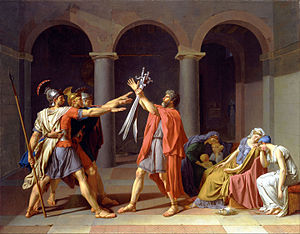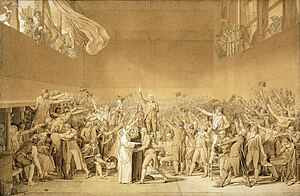การคารวะแบบโรม


การคารวะแบบโรม (อิตาลี: saluto romano) กระทำได้โดยการยืดแขนจนสุดไปข้างหน้า คว่ำมือลงและนิ้วจรดตรง ในบางวัฒนธรรมแขนจะเอียงขึ้นเป็นมุมเล็กน้อย บ้างก็ตั้งแขนตรงขนานไปกับพื้นดิน ซึ่งในวัฒนธรรมร่วมสมัย คนส่วนจำนวนมากมองการคารวะแบบนี้เป็นสัญลักษณ์ของลัทธิฟาสซิสต์ซึ่งต่างรับรู้กันว่านำเอามาจากขนบธรรมเนียมสมัยกรุงโรมโบราณ อย่างไรก็ตาม เรื่องการคารวะแบบโรมนี้ไม่เคยถูกกล่าวถึงในงานเขียนของนักประวัติศาสตร์โรมันคนใดเลย[1] แต่หลักฐานกลับปรากฏในงานประติมากรรมของโรมัน อาทิรูปสลัก เอากุสตุสแห่งปรีมาปอร์ตา เป็นต้น
ในวัฒนธรรมโรมัน มือข้างขวาถูกใช้เพื่อแสดงถึงความซื่อสัตย์, มิตรภาพ และความภักดี[2] ดั่งเช่นที่กิแกโรเคยระบุว่าอ็อกตาวิอุสได้กล่าวปฏิญาณตนต่อจูเลียส ซีซาร์พร้อมเหยียดมือขวาไปข้างหน้า[3]
ราวปลายคริสต์ศตวรรษที่ 18 ตรงกับช่วงการปฏิวัติฝรั่งเศส ซึ่งเป็นยุคที่ลัทธิสาธารณนิยมและจักรวรรดินิยมกำลังเบ่งบาน จิตรกรฝรั่งเศสนามว่า ฌัก-หลุยส์ ดาวีด ได้นำเอาวัฒนธรรมโรมันหลายๆอย่างไปสะท้อนผ่านงานจิตรกรรมนีโอคลาสสิกของเขา จนในที่สุดเกิดเป็นวัฒนธรรมประชานิยมในช่วงปลายศตวรรษที่ 19 และต้นศตวรรษที่ 20 ในหลายประเทศยุโรปรวมถึงสหรัฐอเมริกา

ขบวนการฟาสซิสต์ในประเทศอิตาลีได้นำท่าคารวะนี้ไปเป็นสัญลักษณ์เคลื่อนไหว และหลังปีค.ศ. 1923 ก็กลายเป็นท่าคารวะของรัฐบาลฟาสซิสต์ ทั้งอิตาลี, เยอรมนี, ออสเตรีย และรัฐฟาสซิสต์อื่นๆ การที่ท่าทางนี้ถูกนำไปใช้โดยระบอบฟาสซิสต์ทำให้เกิดข้อถกเถียงขึ้นในสหรัฐว่าควรใช้ท่าทางนี้เป็นท่าเคารพธงชาติสหรัฐหรือไม่[4] ซึ่งในที่สุดรัฐสภาสหรัฐก็ได้ออกกฎหมายยกเลิกท่าคารวะแบบนี้ในปีค.ศ. 1942
อ้างอิง
- ↑ Winkler (2009), p. 2
- ↑ K.E. Georges, Ausführliches lateinisch-deutsches Handwörterbuch, Leipzig, Hahn'sche Verlags-buchhandlung Lateinisch-deutscher theil. 1879–80. 2 v.--Deutsch-lateinischer theil 1882 2 v (reprint Berlin 2007), s.v. "dexter"; cf. Lewis-Short s.v. "dextera"; cf. LSJ s.v. "δεξιά".
- ↑ It is unknown if Octavian's specific oath salute was a pre-existing Roman custom or if he modified a similar pledging gesture for his contio, but Cicero clearly disapproved of Octavian's performance, exclaiming: "I don't want to be saved by such a man"; cf. Cic. Att. 16.15.3.6: Quamquam enim †postea† in praesentia belle iste puer retundit Antonium, tamen exitum exspectare debemus. at quae contio! nam est missa mihi. iurat "ita sibi parentis honores consequi liceat" et simul dextram intendit ad statuam. μηδὲ σωθείην ὐπό γε τοιούτου! [Nec servatoribus istis!]
- ↑ Ellis, Richard (2005). To the Flag: The Unlikely History of the Pledge of Allegiance (illustrated ed.). University Press of Kansas. pp. 113–116.
ดูเพิ่ม
Text is available under the CC BY-SA 4.0 license; additional terms may apply.
Images, videos and audio are available under their respective licenses.
